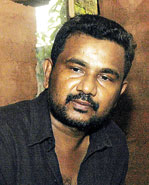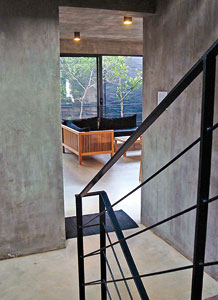“Architecture is about sensing and feeling. It is an entirety, like any form of art. Art is about totality not just the sum of its parts. And in the process of creating art you discover yourself. This applies to anyone, not just an architect. Whether you’re a filmmaker or painter it helps you find out who you are,” says Thisara Thanapathy, winner of the coveted Geoffrey Bawa Award 2010/2011 for Excellence in Architecture.
Thisara’s winning design was the Sarath Abeyrathne House at Colombo 5 while he also received an honourable mention for the Holiday Bungalow at Ulpatha, Matale.
Growing up Thisara lived with his ten brothers and sisters in the then rural countryside of Boralesgamuwa. His artistic influences came from his family. “My mother could paint very well,” Thisara recalls. “She also loved poetry. When I was a child I did a lot of art. My brothers also used to draw well. I remember playing in the paddy fields and in general spending a lot of time outdoors. Growing up in that sort of experience helped nurture artistic senses.”
 |
| Thisara: Childhood exposure to art was a stepping stone to architecture. |
It is these experiences that helped the 46-year-old Thisara become the successful architect he is today. “Even today when I advise the younger generation about getting into the field of design I say you need a childhood connected to it. In the end that is what will help you.”
After completing his secondary level education with excellent results, it was his principal at Vidyakara College who first suggested a career in architecture. “After getting good results for Science, Art and Mathematics the principal said I should get into the field of architecture.” Later Thisara attended Ananda College at Colombo and his one goal was to enter university. Not only did he get sufficient results to enter University but he qualified to study engineering. “I could have gone into the Engineering Faculty. But I selected architecture. I knew that was what I wanted to do,” he says.
Thisara entered the University of Moratuwa in 1984. “Our school system spoon-feeds you up until high school and then when you enter the university, it is very difficult,” says Thisara. “I think the biggest challenge is that you must learn on your own. Also without an artistic background you might find it difficult to study architecture.”
Emerging from university as a young architect he was fortunate to be employed under the guidance of Ashley De Vos, Professor Gemunu Fernando and Suranjith de Silva at the architectural firm Design Group Five. “I had the opportunity of working with other individuals from the industry and they helped me a lot in my career. The people you work alongside really matter,” he says, also mentioning engineer Vasantha Rathnayake whom he still works with him.
Discussing the importance of developing your own style while keeping in mind the humane aspect of design, he says that consumerist demands and middle class ambition should not be the focal point of an architect. He has utter disregard for what he calls unethical exhibitionism seen in some structures in today’s urban regions. “They seem to lack the timeless beauty of the old vernacular architecture. You must learn to fuse the modern with that. Sometimes I regret being a sensitive architect because it makes me sad and angry to see architecture being so commercialized. Cities are full of badly designed buildings and sometimes one has to work with individuals who are not sensitive to nature or the human aspect of architecture. This is very difficult for me.”
“Architecture like most things is governed by economic and political forces,“ he goes on. “As a professional you must learn to stand against that for the betterment of the people. Young professionals entering the field get carried away with social prestige, wealth and ambition. Especially students who come from a rural background are influenced by the wrong reasons. They forget that they must use their education for the development of the country.”
Thisara also stresses on the meaningfulness of architecture. He believes that the structures one creates must be aesthetically pleasing while addressing issues like environmental change, the scarcity of space and prevailing poverty. “The work you do must be contemporary,” explains Thisara. “It must address current issues faced by the community today. We must think of preserving greenery and overcoming the constant stress factors present in the lives of people.
 |
| The winning design: A view of the Sarath Abeyrathne House |
Your design must give solutions to the deeper issues of society. Looking at the work of some young architects, I feel that when you are young you try to see the beauty of a space without it being meaningful but when you mature so does your work. You learn to appreciate that meaningfulness and try to express more than just the surface beauty.”
He speaks of his admiration for South Asian architecture. “I think it is important to create contemporary architecture with a strong cultural identity. That is why I like the work of Geoffrey Bawa. I also like the styles of the Japanese architect Kengo Kuma and the Mexican architect Luis Barragan, because their designs while being humane and modern at the same time relate culturally.”
Not very keen on expressing his emotions on winning the coveted award, he is nevertheless appreciative of the award and the opportunity if affords to further his knowledge. “When people win an award they think this is it. They think their work is as good as it can get but that is not so. You can’t stop there. You have to keep at it and try to improve your work all the time. You must challenge yourself to create something better, always.” |



